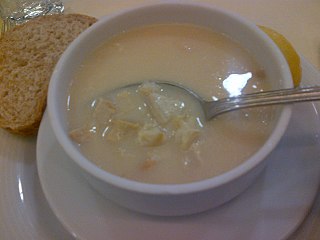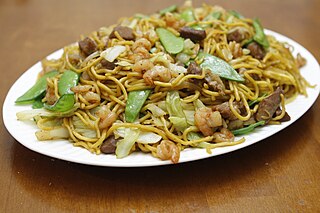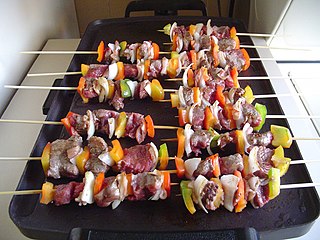Related Research Articles

Tripe is a type of edible lining from the stomachs of various farm animals. Most tripe is from cattle, pigs and sheep.

Puerto Rican cuisine has its roots in the cooking traditions and practices of Europe, Africa and the native Taínos. Since the latter part of the 19th century, Puerto Rican cuisine can be found in several other countries.

Tripe soup, tripe stew or tripe chorba is a soup or stew made with tripe. It is widely considered to be a hangover remedy.

Salvadoran cuisine is a style of cooking derived from the nation of El Salvador, derived from both Mesoamerican and Spanish origins. Many of the dishes are made with maize (corn). There is also heavy use of pork and seafood.

Pörkölt is a meat stew which originates from Hungary, but is eaten throughout Central Europe.

Pancit, also spelled pansít, is a general term referring to various traditional noodle dishes in Filipino cuisine. There are numerous types of pancit, often named based on the noodles used, method of cooking, place of origin, or the ingredients. Most pancit dishes are characteristically served with calamansi.

Czech cuisine has both influenced and been influenced by the cuisines of surrounding countries and nations. Many of the cakes and pastries that are popular in Central Europe originated within the Czech lands. Contemporary Czech cuisine is more meat-based than in previous periods; the current abundance of farmable meat has enriched its presence in regional cuisine. Traditionally, meat has been reserved for once-weekly consumption, typically on weekends. The body of Czech meals typically consists of two or more courses; the first course is traditionally soup, the second course is the main dish, and the third course can include supplementary courses, such as dessert or compote. In the Czech cuisine, thick soups and many kinds of sauces, both based on stewed or cooked vegetables and meats, often with cream, as well as baked meats with natural sauces (gravies), are popular dishes usually accompanied with beer, especially Pilsner, that Czechs consume the most in the world. Czech cuisine is also very strong in sweet main courses and desserts, a unique feature in European cuisines.

Noodle soup refers to a variety of soups with noodles and other ingredients served in a light broth. Noodle soup is a common dish across East Asia, Southeast Asia and the Himalayan states of South Asia. Various types of noodles are used, such as rice noodles, wheat noodles and egg noodles.

Honduran cuisine is a fusion of Mesoamerican (Lenca), Spanish, Caribbean and African cuisines. There are also dishes from the Garifuna people. Coconut and coconut milk are featured in both sweet and savory dishes. Regional specialties include fried fish, tamales, carne asada and baleadas. Other popular dishes include meat roasted with chismol and carne asada, chicken with rice and corn, and fried fish with pickled onions and jalapeños. In the coastal areas and the Bay Islands, seafood and some meats are prepared in many ways, including with coconut milk.
Dominican cuisine is made up of Spanish, indigenous Taíno, Middle-Eastern and African influences. Many Middle-Eastern dishes have been adopted into Dominican cuisine, such as the "Quipe" that comes from the Lebanese kibbeh.

Most traditional foods in Guatemalan cuisine are based on Maya cuisine, with Spanish influence, and prominently feature corn, chilies and beans as key ingredients. Guatemala is famously home to the Hass avocado and the birthplace of chocolate, as first created by the Mayans.

West African cuisine encompasses a diverse range of foods that are split between its 16 countries. In West Africa, many families grow and raise their own food, and within each there is a division of labor. Indigenous foods consist of a number of plant species and animals, and are important to those whose lifestyle depends on farming and hunting.

Nigerian cuisine consists of dishes or food items from the hundreds of ethnic groups that comprise Nigeria. Like other West African cuisines, it uses spices and herbs with palm or groundnut oil to create deeply flavored sauces and soups.

A meatball is ground meat rolled into a small ball, sometimes along with other ingredients, such as bread crumbs, minced onion, eggs, butter, and seasoning. Meatballs are cooked by frying, baking, steaming, or braising in sauce. There are many types of meatballs using different types of meats and spices. The term is sometimes extended to meatless versions based on vegetables or fish; the latter are commonly known as fishballs.

Gambian cuisine is part of West African cuisine and includes the culinary practices and traditions of the nation of The Gambia. Common ingredients include fish, rice, peanuts, tomato, black-eyed peas, lemon, cassava, cabbage, salt, pepper, onion, chili, and various herbs. Oysters are also a popular food from the River Gambia, and are harvested by women.

Dumpling is a broad class of dishes that consist of pieces of dough wrapped around a filling, or of dough with no filling. The dough can be based on bread, flour or potatoes, and may be filled with meat, fish, cheese, vegetables, fruits or sweets. Dumplings may be prepared using a variety of methods, including baking, boiling, frying, simmering or steaming and are found in many world cuisines.
References
Gironella De'angeli, Alicia. Larousse de la cocina mexicana. (2006). ISBN 9789702216858









